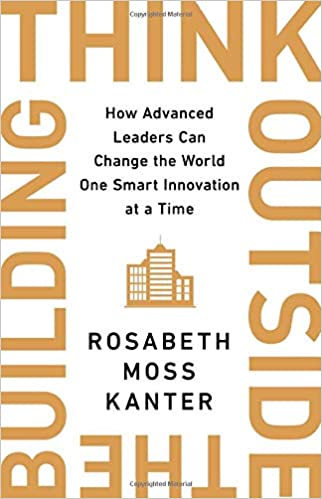You have /5 articles left.
Sign up for a free account or log in.
 Think Outside the Building: How Advanced Leaders Can Change the World One Smart Innovation at a Time by Rosabeth Moss Kanter
Think Outside the Building: How Advanced Leaders Can Change the World One Smart Innovation at a Time by Rosabeth Moss Kanter
Published in January 2020
For years, I’ve been curious about the Advanced Leadership Initiative at Harvard University. ALI is famous in higher ed circles for pioneering a new type of educational program.
ALI is a program designed for high-achieving professionals who are at the stage where they can comfortably retire, but whose idea of retirement is to not to spend their time traveling or relaxing but to change the world. Call this “impact retirement,” a commitment to leave a legacy and contribute beyond what is ordinarily capable in a given profession.
Luckily, the person who started ALI at Harvard is the incomparable Rosabeth Moss Kanter. Not only is Kanter brilliant, as anyone who has read her previous books can attest, she is also a sociologist. This means that Kanter is almost disciplinarily compelled to write about ALI, and to place the Harvard program in a broader context of organizational and social change.
Think Outside the Building is the origin story of the Advanced Leadership Institute and a synthesis of the curriculum that ALI fellows experience. The stories of the projects that ALI fellows initiated in their year at Harvard form the backbone of the book’s content. Kanter provides deep dives into the stories of former Trader Joe's president Doug Rauch’s founding of Daily Table (addressing nutrition, poverty and sustainability); the Brazilian social justice media platform Catraca Livre’s founder, Gilberto Dimenstein; and many others.
Throughout Think Outside the Building, Kanter emphasizes that what matters most in any significant change initiative is the power of ideas and the importance of coalition building and systems thinking in bringing ideas to impact. The challenge with societywide problems, from poor nutrition to student debt to gun violence (among others discussed in the book), is that no one group owns the problem. These are cross-sector and cross-industry challenges and almost always include a multitude of stakeholders and interest groups.
The ability to exert impact on positively addressing any big societal problems requires that advanced leaders work effectively across domains of government and business, public policy and individual incentives. Think Outside the Building is full of sound advice, clear frameworks and relatable stories for anyone looking to tackle seemingly intractable local, regional, national and global challenges.
I wish that Kanter had spent more time discussing the inside baseball stories of the development and running of ALI. A book about organizational change at Harvard would have been, of course, a different book. Think Outside the Building is aimed mostly, I suspect, at a similar demographic to ALI attendees -- those who are on the cusp of retirement, are financially secure and who desire to spend the next phase of their lives drawing on their contacts and skills and resources to make a difference in the world.
If Think Outside the Building had been written for a higher ed audience, Kanter would have spent more time explaining how to develop something new at an old (in Harvard’s case almost 400-year-old) institution.
In reading the book, I kept wanting Kanter to describe the revenue model for ALI. What was the up-front investment? How did she build a coalition of university leaders to champion and teach in the program? What were the capabilities that Harvard had to develop to design productive learning environments for ALI fellows? What is the role of technology in the program? The book was written pre-pandemic, but I kept wondering how a program designed around social learning and in-person networking will pivot in the face of social distancing.
Kanter does talk about the growth of ALI-like programs at Stanford, Notre Dame and the University of Texas. I’d like to know more about the size of the market for educational programs for ambitious retirees. A few years ago, I taught a class about the future of higher education for the Osher Lifelong Learning Institute at my college. My students, average age somewhere north of 65, were among the most engaged and inquisitive of any group of learners I’ve worked with throughout my career.
The students I taught, however, paid only a nominal fee to learn with me. Students in Harvard’s ALI pay many thousands of dollars, although how many thousands I don’t know. Kanter does not give the tuition cost, and I can’t find the figure on the website. Somewhere more than $50,000, I suspect, which is the number I found from a 2011 article in Boston.com.
Understanding the economics of programs like ALI will likely be necessary for many institutions of higher learning. The demographic trajectory for traditional students is bleak, and the market for executive education programs and specialized master's for adult working professionals is likely saturated.
Rosabeth Moss Kanter would be on my short list of academics that I’d want to sit next to at a dinner party. You get the feeling from reading Think Outside the Building that Kanter is a terrific listener. That she would connect you with an entire network of people that you didn’t know you should meet. And that she would provide you with some invaluable advice on the next stage of your career.
As nowadays we do not have dinner parties, and I suspect that Kanter’s calendar is likely rather full at all times, reading Think Outside the Building is likely our best opportunity to spend time with this fascinating and wise academic.
What are you reading?




